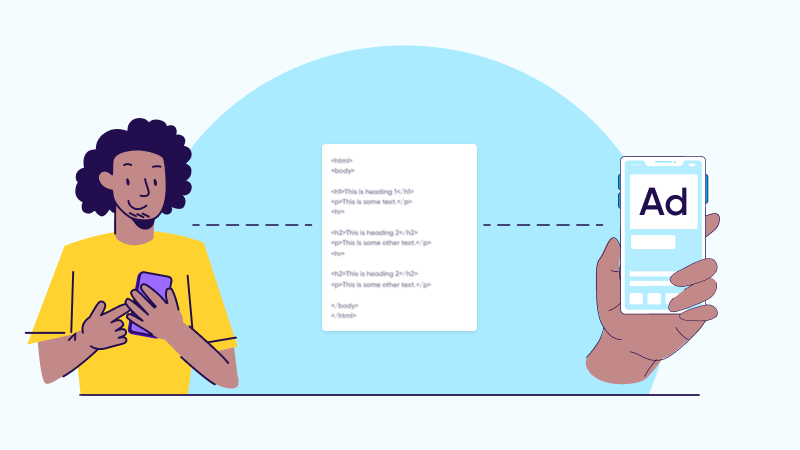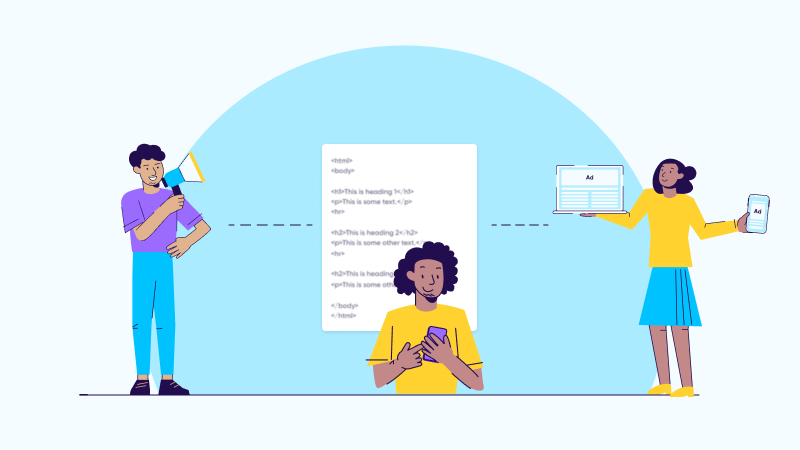
Bid request

A bid request is a piece of code used to sell display ads and inventory details. It allows visitors to see ads most suited to them, and for multiple advertisers to utilize the same ad spot on a given publisher’s platform.
What is a bid request?
Computers are extremely fast at processing data and making decisions. With bid requests, the exact ads on the page aren’t determined until visitors reach the app or website. As soon as they do, the bid request is automatically generated to provide information about available impression inventory and consenting visitor demographics (age, gender, location, visited websites, etc.).
This language of code is used in header bidding, exchange bidding, and real-time bidding (RTB).
Do you have to bid in real-time for all ad spaces?
Programmatic buying is an option for advertisers who want to use programmatic advertising without the unknowns of real-time automated buying. Programmatic buying works well for high-cost premium display formats because it guarantees the location and context.
However, it can only project an expected audience because it doesn’t send out a bid request for each visitor. Because of that, it cannot guarantee visitors are always within the ad’s target audience.
How are bid requests used?
Bid requests help quickly pull the right ad for the current visitor.
For example, a bid request could be used to target users who have recently visited your or a competitor’s website or app. Bid requests will include information sent by the ad exchangers about the web visitors, such as cookies, tags, and pixels, and the platform (inventory details and number of impressions), or app users information such as IDFA.
Using bid requests, a company could also avoid advertising to segments of the audience who had recently made a purchase, focusing instead on new leads for a brand awareness campaign.
Pros and cons of using bid requests to place ads
Real-time bidding makes it possible for websites and platforms to show ads based on their visitors and not a one-size-fits-all placement based on the web page.
Advertisers can buy and sell ad inventory on a per-impression agreement, targeting their audience with real-time data and setting parameters for specific campaigns or ad priorities.
However, there’s a concern that ads will be placed in inappropriate places. Algorithms, keywords, and gleaned information from bid requests may not always get it right. Without human input, certain ads might not fit into the content of the page well, creating a contrast that can seem insensitive or tasteless.
To avoid this, advertisers need to understand the potential for misplacement and consider possible pairings that might hurt their campaigns.
Real-time bidding works best for ads that appeal to large audience segments and can’t easily be paired with content that changes their meaning. Narrowing the campaign parameters may help reduce the potential misplacements that could occur by limiting how many sites or content types qualify for a bid.
How does it actually work?

As soon as a user visits the web page or a user hits an app, the bid request is generated and pulls various data points based on the consenting user, page, and site analytics. This information is then passed to the ad exchange, where it’s shared with advertisers.
Based on the context provided by the bid request, advertisers place bids in real-time for ads they have ready and waiting. An ad server is used to choose the highest bid and instantly place the winning ad on the page.
The entire process lasts less than a second and occurs as the page is loading.
One page can have multiple ad slots with a different bid request for each one, which allows other advertisers to find placement on the same page.
What information is provided in a bid request?
The bid request code attempts to get as much relevant information as possible to pass on to potential advertisers. Examples of data that may be gleaned from a bid request include:
- Time of impression clarifies when the user actively sees the ad.
- User demographics provide any known information about the consenting user (gender, age, etc.).
- Browsing history includes information about prior websites visited to shed light on potential interests for targeting ads.
- The geo location of the consenting user can help determine relevance for shopping apps with limited reach or service areas.
- Page information, including content and analytics relevant to ad value.
- User-level data (when applicable) provides information useful for remarketing or unique ad views.
Not every bid request will be able to gather all of the requested information on each visitor. When data is not available — such in the case of iOS 14+ non-consenting users, it may affect which advertisers are vying for the ad spot.
For example, an ad targeting local customers may not try to win the bid for a visitor with no location information available.
Key takeaways
Bid requests allow advertisers and publishers to work out a mutually beneficial ad spend deal.
The information gathered makes it possible for the advertiser to target their ideal audience, but it also helps the publisher get the most out of each ad spot. Bid requests make it possible for publishers to take the highest bid and increase the value of the spot for the advertiser.
So, to sum it up, here are the important points on bid requests and real-time bidding:
- Bid requests make it possible to gain data from web pages or apps for real-time bids for digital or mobile advertisements.
- Rather than pay for placement on a specific site, open auction (or real-time bidding) in programmatic advertising allows companies to target their audiences.
- Information gathered by bid requests helps advertisers engage specific audience groups who are more likely to be positively influenced by their ad.
- Bid requests make it possible to provide a more personalized experience for the audience by showing ads aligned with their behavior or interests.
- Bid requests happen almost instantly and allow real-time bidding to take place. The publisher approves the highest bid for each spot, and the viewer experiences a nearly seamless loading process with targeted ads.
- Advertisers have control over the real-time bidding process and can set parameters for focusing on key information or capping the spend.
- With computer programs rather than people running the ads, there is a potential for ad mismatching, insensitive placement, or other issues. Careful consideration should be given to the parameters set and how poor placement can be avoided if there are any potential threats.



